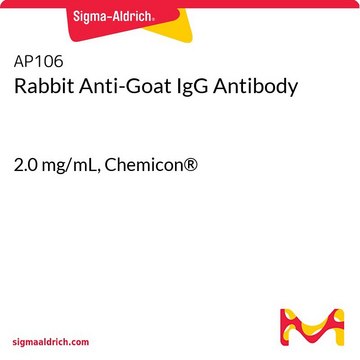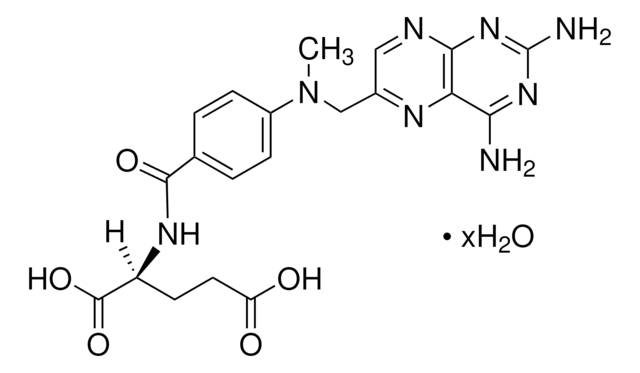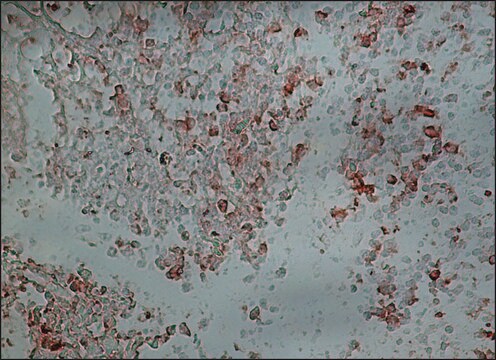Alle Fotos(1)
Wichtige Dokumente
H2414
Anti-Humanin (HN) antibody produced in rabbit
affinity isolated antibody, buffered aqueous solution
Synonym(e):
Humanin Detection Antibody, Rabbit Anti-Humanin
Anmeldenzur Ansicht organisationsspezifischer und vertraglich vereinbarter Preise
Alle Fotos(1)
About This Item
Empfohlene Produkte
Biologische Quelle
rabbit
Qualitätsniveau
Konjugat
unconjugated
Antikörperform
affinity isolated antibody
Antikörper-Produkttyp
primary antibodies
Klon
polyclonal
Form
buffered aqueous solution
Speziesreaktivität
human
Methode(n)
western blot: 1:500
Versandbedingung
dry ice
Lagertemp.
−20°C
Posttranslationale Modifikation Target
unmodified
Angaben zum Gen
human ... MT-RNR2(4550)
Allgemeine Beschreibung
Humanin (HN) is a small polypeptide, derived from mitochondria. This protein is secreted by various cells and is localized in the plasma and bound to the cell membranes.
Immunogen
peptide corresponding to the humanin protein (amino acids 9-24).
Anwendung
Anti-Humanin (HN) antibody produced in rabbit has been used in:
- immunohistochemistry
- immunoprecipitation (1:300)
- fluorescent immunohistochemistry (1:300)
- immunoblotting (1:500)
Biochem./physiol. Wirkung
Humanin (HN) acts as a neuroprotective factor. It is involved in promoting cell survival. Humanin suppresses cell death in the neuronal cells caused by Alzheimer′s disease-related insults like anti-amyloid- precursor protein antibody, neurotoxic amyloid β (Aβ) peptides, and familial Alzheimer disease proteins.
Physikalische Form
Solution of 1 mg/mL in phosphate buffered saline containing 0.02% sodium azide.
Haftungsausschluss
Unless otherwise stated in our catalog or other company documentation accompanying the product(s), our products are intended for research use only and are not to be used for any other purpose, which includes but is not limited to, unauthorized commercial uses, in vitro diagnostic uses, ex vivo or in vivo therapeutic uses or any type of consumption or application to humans or animals.
Sie haben nicht das passende Produkt gefunden?
Probieren Sie unser Produkt-Auswahlhilfe. aus.
Lagerklassenschlüssel
10 - Combustible liquids
WGK
nwg
Flammpunkt (°F)
Not applicable
Flammpunkt (°C)
Not applicable
Hier finden Sie alle aktuellen Versionen:
Besitzen Sie dieses Produkt bereits?
In der Dokumentenbibliothek finden Sie die Dokumentation zu den Produkten, die Sie kürzlich erworben haben.
Mariela A Moreno Ayala et al.
Scientific reports, 10(1), 8542-8542 (2020-05-24)
Humanin (HN) is a mitochondrial-derived peptide with cytoprotective effect in many tissues. Administration of HN analogs has been proposed as therapeutic approach for degenerative diseases. Although HN has been shown to protect normal tissues from chemotherapy, its role in tumor
Radhika H Muzumdar et al.
PloS one, 4(7), e6334-e6334 (2009-07-23)
Decline in insulin action is a metabolic feature of aging and is involved in the development of age-related diseases including Type 2 Diabetes Mellitus (T2DM) and Alzheimer's disease (AD). A novel mitochondria-associated peptide, Humanin (HN), has a neuroprotective role against
Jon-Philippe K Hyatt
Physiological reports, 10(13), e15377-e15377 (2022-07-10)
Skeletal muscle adapts to aerobic exercise training, in part, through fast-to-slow phenotypic shifts and an expansion of mitochondrial networks. Recent research suggests that the local and systemic benefits of exercise training also may be modulated by the mitochondrial-derived peptide, MOTS-c.
Changhan Lee et al.
Trends in endocrinology and metabolism: TEM, 24(5), 222-228 (2013-02-14)
Mitochondria have been largely considered as 'end-function' organelles, servicing the cell by producing energy and regulating cell death in response to complex signals. Being cellular entities with vital roles, mitochondria communicate back to the cell and actively engage in determining
Carla Janzen et al.
PloS one, 13(3), e0193583-e0193583 (2018-03-29)
Intrauterine growth restriction (IUGR) results from a lack of nutrients transferred to the developing fetus, particularly oxygen and glucose. Increased expression of the cytoprotective mitochondrial peptide, humanin (HN), and the glucose transporter 8, GLUT8, has been reported under conditions of
Unser Team von Wissenschaftlern verfügt über Erfahrung in allen Forschungsbereichen einschließlich Life Science, Materialwissenschaften, chemischer Synthese, Chromatographie, Analytik und vielen mehr..
Setzen Sie sich mit dem technischen Dienst in Verbindung.








